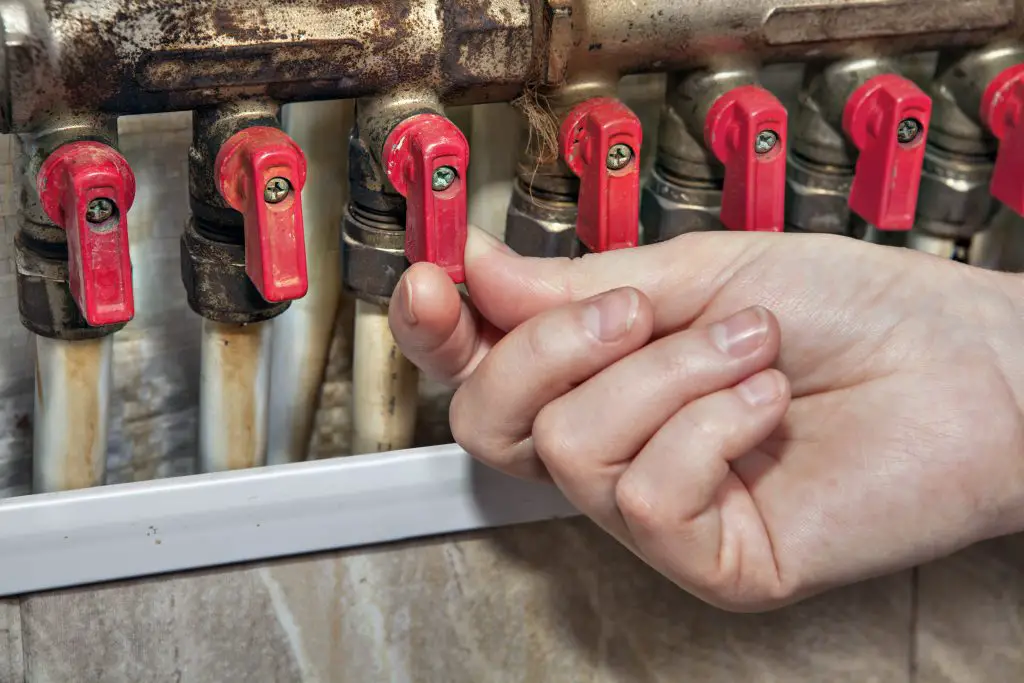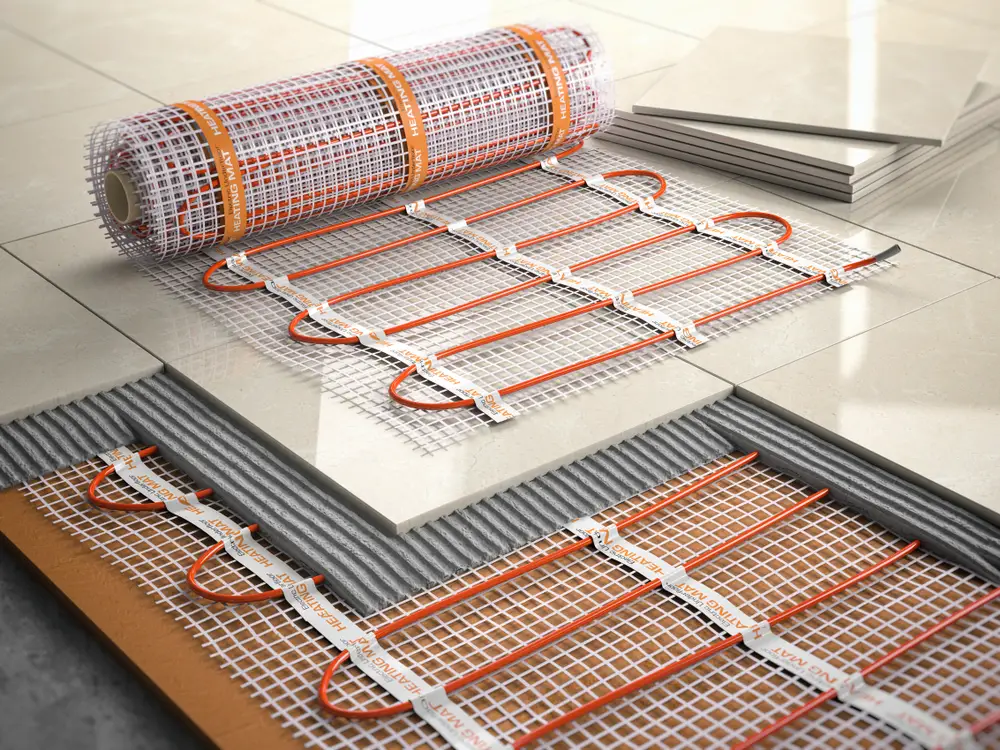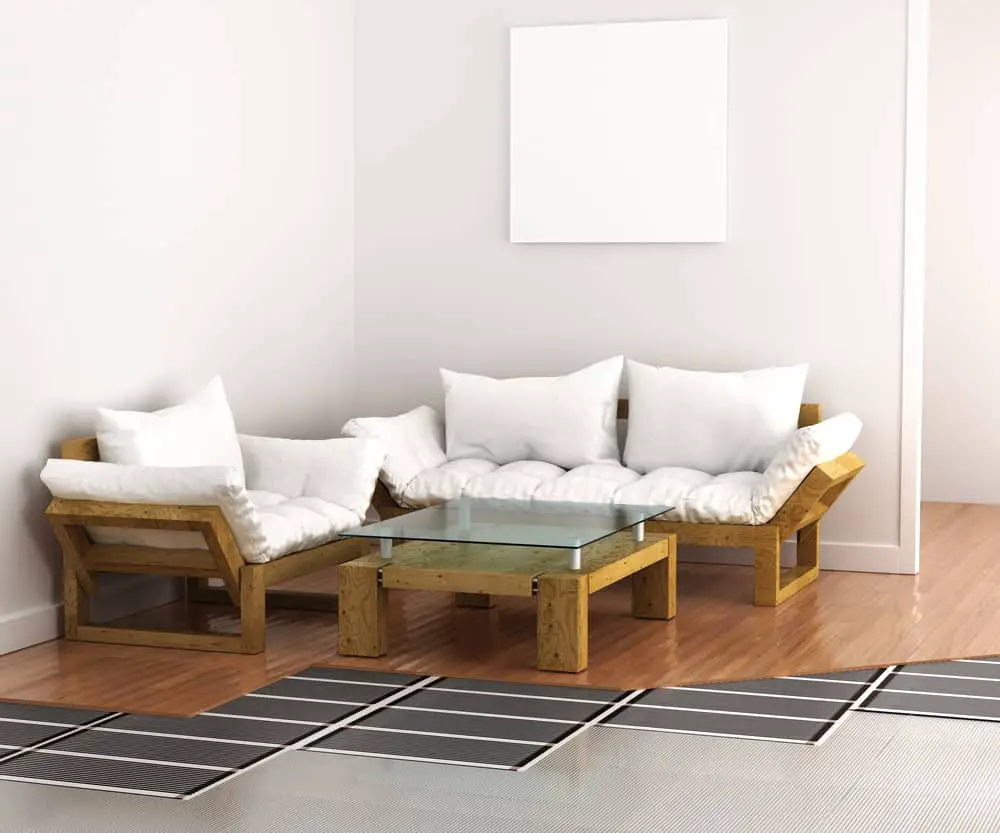Knowing when to switch on the radiant heating throughout the home can be a challenge, with many first-time owners switching the system on and off frequently, greatly reducing efficiency. Radiant underfloor heating can be a challenge to work with if you have never had such a complete home heating system before.
You should leave your radiant underfloor heating on at all times, especially in very cold winter conditions. This is because underfloor heating systems take hours to heat up to comfortable temperatures. It is often advised that instead of switching off completely, the temperature should be at the minimum, for faster warm-up times.
Underfloor heating systems should be paired with programmable or even smart thermostats. These thermostats learn the heating patterns which include switching off when no one is at home, reducing the temperature at night times, and heating up just before everyone returns. The smart thermostat then schedules the heating cycle automatically based on the information gathered.

What are the pros and cons of having your underfloor heating on all the time?
It is vital to remember that the pros and cons of the two types of underfloor radiant heating changes dramatically depending on what you are using. How these will affect your day-to-day goings should always be remembered with several of the pros of one not being present when using the other.
Pros of Water Underfloor Heating being left on
Water radiant underfloor heating has the benefit of becoming significantly more effective the longer the system is left on. Water-based systems can keep ambient heat a lot better than electric systems, which means that overall, the system may use a lot less electricity than you would when starting and stopping it constantly.
Another advantage of leaving water underfloor heating on at all times is the amount of energy you save by not having to heat the home from scratch each time. Radiant underfloor heating systems use the most amount of energy when they have to heat the entire room from scratch.
Cons of leaving water underfloor systems on
Water systems can quickly reach the end of their lives with pumps backing up or air bubbles being introduced, which is why so many of these systems rely on a smart control system. Having a system that is constantly on will drastically increase the ambient temperatures in your home but will negatively affect the overall life of your radiant heating system.
Mechanical components such as the actuators and flow valves can also fail quickly if they get overworked as a result of the constant switching required to regulate the system.

Pros of electric underfloor heating left on
There is no added advantage of leaving electric underfloor heating on all the time, as leaving the system on just adds to running cost. Electric underfloor heating systems heat up faster, compared to water underfloor systems, so it’s best to just switch it on when it’s needed. Smart thermostats also come in handy as they are programmed to come on at specific times to ensure the home is always warm enough.
Cons of leaving electric underfloor systems on
The major disadvantage of leaving electric underfloor heating on is the overall increase in costs for your electric bill during the winter months. Also since they heat up faster, leaving them on all day just increases the electricity bill. With electric heating systems suffering significantly to keep going, they need to shut off and turn back on to keep going at the same temperature.
Also, every electric panel has a limit to how long it can work, and if you are constantly running the system this limit can be reached quite fast.

When should the underfloor heating be shut down?
There are certain scenarios whereby the underfloor heating system should be shut down. Each of these is specific to its circumstances and should be remembered. Except for extreme situations, these systems should be put off when there’s no one at home.
With underfloor heating, the importance of shutting it down becomes more important when you are away for longer times. Not only can the heating system cause damage to your home if something goes wrong, but what is the point of having a perfectly warm home when there is no one there to enjoy it.
Long workdays
A normal workday only lasts around 8 hours, with a lunchtime break in-between, and leaving the radiant underfloor heating going during this period will easily allow you to return to a comfortable home. Most people prefer to set the heating to a lower level to help save on energy However, if you are going to be away for longer you on a shift-based workday it may be better to shut it down.
People that work shifts or know that their day can last longer than expected prefer to have their systems shut down for most of the day. When doing this it is highly advised to have an automated or smart system that allows you to have the system start automatically before they reach home. This saves the energy from being wasted on heating the home with no one present.
Weekends away
Whether you are going away to a luxury spa or just visiting a friend several towns over, if you know that you won’t be home for most of a weekend the system must be shut down. This allows you to enjoy the weekend away without wasting energy at home.
You should be aware that when you do shut down the system for a weekend there may be some residual heat remaining when you do return. Water-based radiant underfloor heating systems have been known to retain some heat for several hours afterward unlike electric underfloor systems. The better your home is insulated the more likely you are that the system will retain heat even when it is not being used.

Vacations
You should shut down the complete system when you do go on vacation. Many people leave their HVAC system running when they go on vacation, however, with underfloor heating, it will not be advisable to do the same.
Having the system on standstill can be a lot better than having it running for no reason. However, if you have a water-based heating system, it is recommended for it to be kept on always. This is to prevent the water in the pipes from freezing when you are away.
Temperature changes
If the home is getting warmer, and it is starting to get hotter outside you will easily find that using the complete underfloor heating system can be inefficient. Having the system running when it is no longer needed can cause the home to become uncomfortably hot when you least expect it. Radiant underfloor heating systems are fantastic when the outside temperatures are reaching close to freezing.
However, at warmer temperatures the systems can make it uncomfortable to live with, causing a home that would otherwise be nice to live in to be too hot.
Running costs of underfloor heating systems
The running cost of underfloor heating systems is dependent on the room size, how long the system is put on, and the level of insulation in the room. Some tools can be used to calculate the running cost for electric underfloor heating systems.
The running cost of electric underfloor heating systems can be up to 5 times more than the cost of a water underfloor heating system. The table below shows the running cost for water and electric underfloor heating systems according to Nu-Heat, as of March 2019.
| Room Size | Electric Underfloor Heating | Water Underfloor Heating |
| 10 sq meters | £224 | £45 |
| 20 sq meters | £448 | £90 |
| 30 sq meters | £672 | £134 |
Conclusion
You can easily and comfortably leave your underfloor heating system on for as long as you need it, even if you are leaving the home for a few hours. Many people prefer to have their systems on to ensure that the house is warm when they return. This saves a lot of energy(water underfloor heating) and means that you can always walk into your house and be perfectly happy.
For extended periods of home absence, it is best to shut down the underfloor heating systems, in case of faults. This should be done to also avoid overworking the system. The thermostats could also be programmed to switch on the system at specific intervals to ensure the pipes do not freeze.
Lots more Underfloor Heating Information Here
- What Depth is Required for Underfloor Heating?
- Turning on Underfloor Heating for the First Time – How Long to Wait?
- Can you lay Vinyl flooring over underfloor heating?
- Do Tiles Crack With Underfloor Heating?
- Can You Heat a Whole House With Underfloor Heating?
- Can You Have Underfloor Heating Upstairs?
- Will Underfloor Heating Raise My Floor? – Underfloor Heating Layers Explained
- Can I put furniture on top of underfloor heating?
- How Do I Know If My Underfloor Heating is Leaking?
- Can You Combine Underfloor Heating With a Ground Source Heat Pump?
- Is Underfloor Heating Safe?
- Does Underfloor Heating Add Value to a Property?
- Can you have Wooden Floors with Underfloor Heating?
- Can Underfloor Heating Cause a Fire?
- What temperature should Underfloor Heating be set at?
- Can I Put a Rug Over Underfloor Heating?
- How Long Does it Take for Underfloor Heating to Warm Up?
- Why is my Underfloor Heating Noisy?
- Why is my Underfloor Heating Patchy?
- How do I know if My Underfloor Heating is Working? – Common Problems & Fixes
- What can go wrong with underfloor heating?
- Can you Combine Underfloor Heating with an Air Source Heat Pump?
- Do you keep underfloor heating on all the time?
- Does Underfloor Heating work with Smart Thermostats?
- Kitchen Underfloor Heating – Should Underfloor Heating go Under Kitchen Units?
- How much energy does Underfloor Heating use?
- Underfloor Heating in Summer and Winter
- Lifespan of Underfloor Heating
